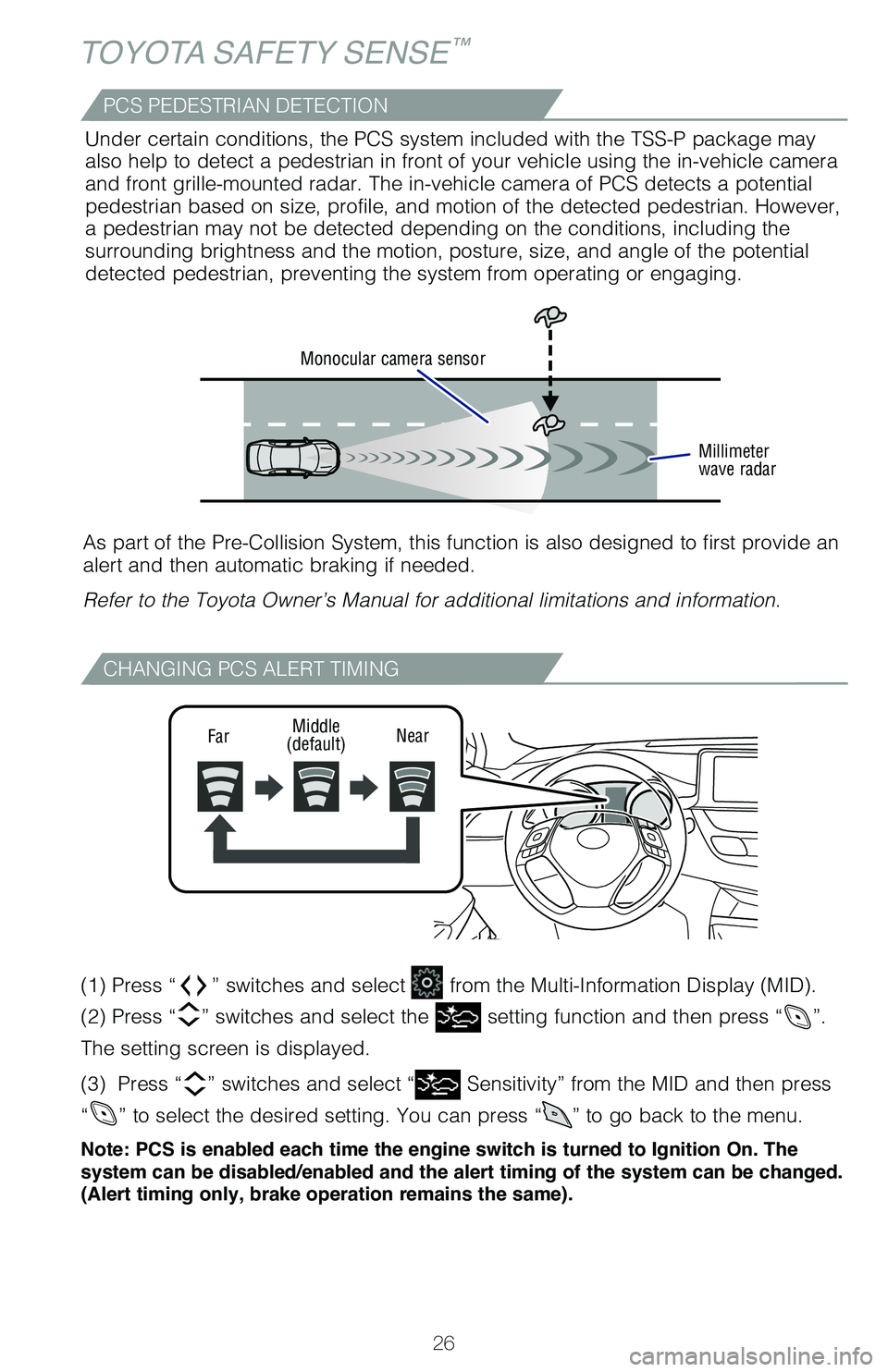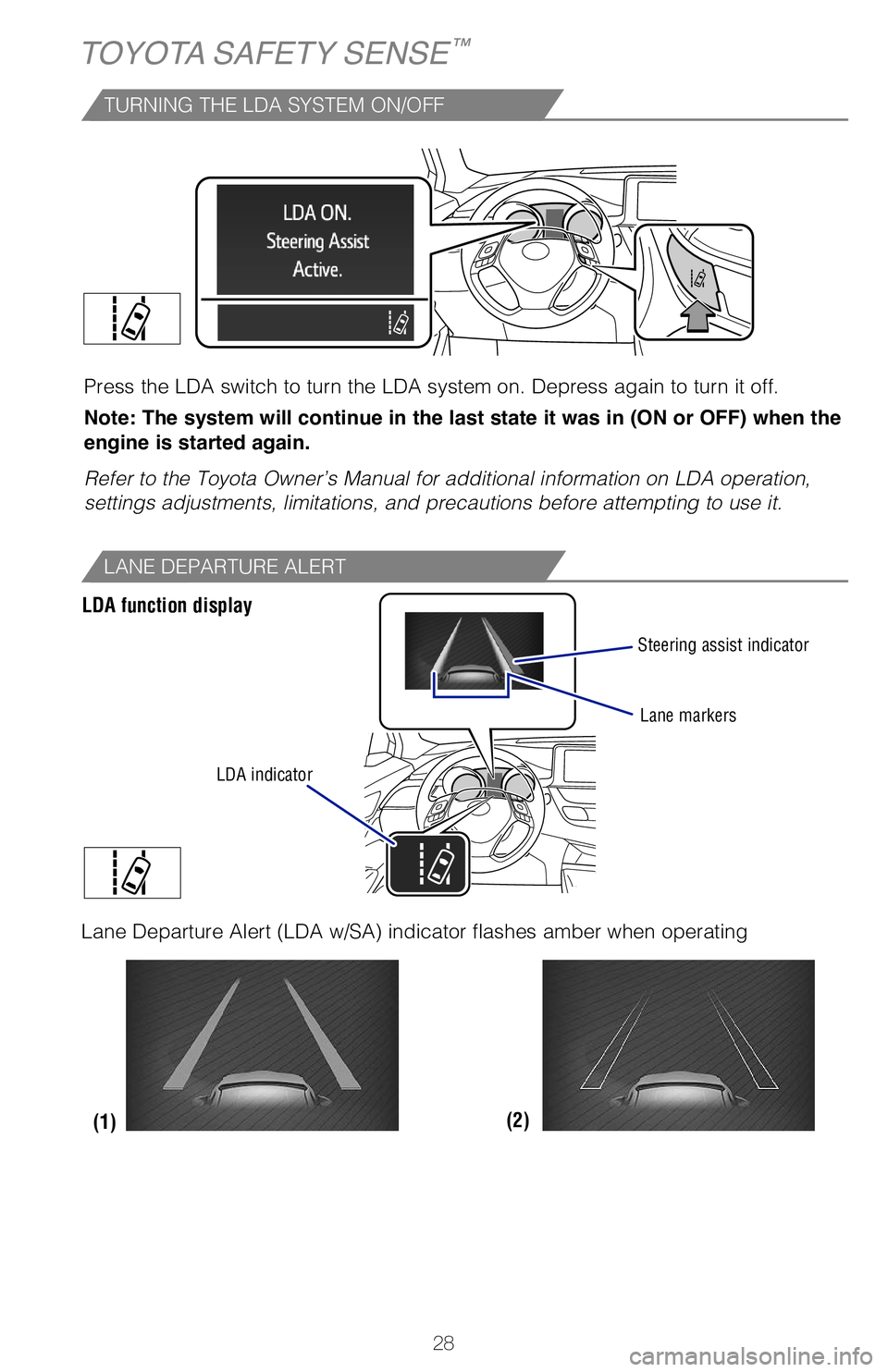engine TOYOTA C-HR 2020 (in English) User Guide
[x] Cancel search | Manufacturer: TOYOTA, Model Year: 2020, Model line: C-HR, Model: TOYOTA C-HR 2020Pages: 48, PDF Size: 3.81 MB
Page 22 of 48

20
FEATURES & OPERATIONS
The engine switch must be in the “ACC” or “ON” position (witho\
ut Smart Key) /
“ACCESSORY” or ”IGNITION ON” mode (with Smart Key) for use.
(1)(2)
Pull
Pull
Power outlet-12V DC
Audio
NOTE: Concentrating on the road should always be your first priority while
driving. Do not use the Audio Multimedia System if it will distract you.
Refer to the “Navigation and Multimedia System Owner’s Manual” or vi\
sit www.
toyota.com/audio-multimedia for additional resources.
Touch screen display
Access
AUDIO screen
Push to turn ON/OFF or
turn to adjust volume Turn to tune radio stations
manually or select tracks or filesAccess Bluetooth
hands-free
system
Seek station/
track/file
select
Access
HOME screen
Access
MENU screen
Access
Toyota apps
screen
Access
MAP screen
Page 28 of 48

26
CHANGING PCS ALERT TIMING
TOYOTA SAFETY SENSE™
(1) Press “” switches and select from the Multi-Information Display (MID).
(2) Press “
” switches and select the setting function and then press “”.
The setting screen is displayed.
(3) Press “
” switches and select “ Sensitivity” from the MID and then press
“
” to select the desired setting. You can press “” to go back to the menu.
Note: PCS is enabled each time the engine switch is turned to Ignition On. The
system can be disabled/enabled and the alert timing of the system can be changed.
(Alert timing only, brake operation remains the same).
Far Middle
(default) Near
Monocular camera sensor
Millimeter
wave radar
As part of the Pre-Collision System, this function is also designed to fir\
st provide an
alert and then automatic braking if needed.
Refer to the Toyota Owner’s Manual for additional limitations and informat\
ion.Under certain conditions, the PCS system included with the TSS-P package may
also help to detect a pedestrian in front of your vehicle using the in-vehic\
le camera
and front grille-mounted radar. The in-vehicle camera of PCS detects a pote\
ntial
pedestrian based on size, profile, and motion of the detected pedestrian. However,\
a pedestrian may not be detected depending on the conditions, including t\
he
surrounding brightness and the motion, posture, size, and angle of the potential
detected pedestrian, preventing the system from operating or engaging.
PCS PEDESTRIAN DETECTION
Page 30 of 48

28
TOYOTA SAFETY SENSE™
(2)
(1)
TURNING THE LDA SYSTEM ON/OFF
Press the LDA switch to turn the LDA system on. Depress again to turn it off.\
Note: The system will continue in the last state it was in (ON or OFF) when the
engine is started again.
Refer to the Toyota Owner’s Manual for additional information on LDA opera\
tion,
settings adjustments, limitations, and precautions before attempting to use it.
LANE DEPARTURE ALERT
LDA function display
Lane markers
Steering assist indicator
LDA indicator
Lane Departure Alert (LDA w/SA) indicator flashes amber when operating
Page 35 of 48

33
OVERVIEW
FEATURES & OPERATIONS
TOYOTA SAFETY SENSE
SAFETY & EMERGENCY FEATURES
SWITCHING TO CONSTANT SPEED (CRUISE) CONTROL MODE
If you are already using DRCC “”, push ON-OFF button to turn the system off
first, then push and hold ON-OFF button for at least 1.5 seconds to switch.
Note: When the engine is turned off, it will automatically default to DRCC.
Refer to the Toyota Owner’s Manual for additional information on DRCC oper\
ation,
settings adjustments, limitations, and precautions before attempting to use it.
1.5 seconds
(3) Acceleration when there are no longer any preceding vehicles driving
slower than the set speed
The system accelerates until the set speed is reached. The system then
returns to constant speed cruising.
Note: When your vehicle is too close to a vehicle ahead, and sufficient
automatic deceleration via the cruise control is not possible, the display will
flash and the buzzer will sound to alert the driver. An example of this would be
if another driver cuts in front of you while you are following a vehicle. Depress
the brake pedal to ensure an appropriate vehicle-to-vehicle distance.
ADJUSTING DISTANCE (CONTINUED)
SETTING CONSTANT SPEED (CRUISE) CONTROL
Refer to the Toyota Owner’s Manual for additional information on DRCC oper\
ation,
settings adjustments, limitations, and precautions before attempting to use it.
Set
To adjust speed or cancel, see steps (2) and (3) of ADJUSTING SET SPEED on
page 31.
Page 36 of 48

34
TOYOTA SAFETY SENSE™
Automatic High Beams (AHB)
AHB is a safety system designed to help drivers see more of what’s ahead\
at
nighttime while reducing glare for oncoming drivers. When enabled, AHB uses an
in-vehicle camera to help detect the headlights of oncoming vehicles and tail ligh\
ts
of preceding vehicles, then automatically switches between high and low be\
ams
as appropriate to provide the most light possible and enhance forward visi\
bility.
By using high beams more frequently, the system may allow earlier detectio\
n of
pedestrians and obstacles.
Refer to the Toyota Owner’s Manual for additional information on AHB opera\
tion,
settings adjustments, limitations, and precautions before attempting to use it.
(1) With the engine switch in ON/IGNITION ON mode, turn the headlight switc\
h to “
” or “AUTO” position, then push lever away from you.
(2) Press the “
” switch.
The AHB indicator will come on when the headlights are turned on automatica\
lly
to indicate that the system is active.
Note: Pull the lever back toward you to turn the AHB system off.
The AHB indicator will turn off. To turn switch to “
” position and the manual
high beam indicator “
” turns on.
When all of these conditions are met, high beams will be automatically turne\
d on
(after approximately 1 second): • Vehicle speed is above approximately 21 mph (34 km/h).
• The area ahead of the vehicle is dark.
• There are no oncoming or preceding vehicles with headlights or tail lig\
hts turned on.
• There are few street lights on the road ahead.
If any of these conditions occur, the system is designed to automatically \
turn off
high beams: • Vehicle speed drops below approximately 17 mph (27 km/h).
• The area ahead of the vehicle is not dark.
• Oncoming or preceding vehicles have headlights or tail lightsturned on.
• There are many streetlights on the road ahead.
ACTIVATING THE AHB SYSTEM
CONDITIONS WHERE AHB WILL TURN ON/OFF AUTOMATICALLY
(2) (1)
Page 41 of 48

39
OVERVIEW
FEATURES & OPERATIONS
TOYOTA SAFETY SENSE
SAFETY & EMERGENCY FEATURES
SMART STOP TECHNOLOGY (SST)
Smart Stop Technology automatically reduces engine power when the accelerator\
and brake pedals are pressed simultaneously under certain conditions.
SST engages when the accelerator is depressed first and the brakes are appl\
ied
firmly for longer than one-half second at speeds greater than five miles per h\
our.
SST doesn’t engage if the brake pedal is depressed before the accelerato\
r pedal,
allowing vehicles to start on a steep hill and safely accelerate without rolling\
backward.
Star Safety System™
ANTI-LOCK BRAKE SYSTEM (ABS)
Toyota’s ABS sensors detect which wheels are locking up and limits wheel lockup
by “pulsing” each wheel’s brakes independently. Pulsing releases \
brake pressure
repeatedly for fractions of a second. This helps the tires attain the traction tha\
t
current road conditions will allow, helping you to stay in directional control.\
BRAKE ASSIST (BA)
Brake Assist is designed to detect sudden or “panic” braking, and then \
add braking
pressure to help decrease the vehicle’s stopping distance. When there’s on\
ly a split
second to react, Brake Assist can add additional brake pressure more quickly t\
han
just the driver alone can.
ELECTRONIC BRAKE FORCE DISTRIBUTION (EBD)
Toyota’s ABS technology has Electronic Brake-force Distribution (EBD) to help
maintain control and balance when braking. EBD responds to sudden stops by
redistributing brake force to enhance the braking effectiveness of all four wheels. Your vehicle comes standard with the Star Safety System
TM, which combines Anti-
lock Braking System (ABS), Brake Assist (BA), Electronic Brake-force Dis\
tribution
(EBD), Smart Stop Technology (SST), Traction Control (TRAC) and Vehicle St\
ability
Control (VSC).
Refer to the Owner’s Manual for more details and important information on limitations
to these systems.
ENHANCED VEHICLE STABILITY CONTROL (VSC)
Enhanced Vehicle Stability Control provides cooperative control of the ABS, TRAC\
,
VSC and EPS.
Enhanced VSC helps to maintain directional stability when loss of traction occur\
s
during a turn.
Page 42 of 48

40
Floor mat installation
There are two types of Toyota floor mats: carpeted and all-weather. Each vehi\
cle
has model-specific floor mats. Installation is easy.
To keep your floor mat properly positioned, follow these steps:
• Only use Toyota floor mats designed for your specific model.
• Use only one floor mat at a time, using the retaining hooks to keep the\
mat in place.
• Install floor mats right side up.
Always align the “” marks
TRACTION CONTROL (TRAC)
VSC helps prevent loss of traction during cornering by reducing engine powe\
r, and
Traction Control helps maintain traction on loose gravel and wet, icy, or uneven\
surfaces by applying brake force to the spinning wheel(s).
Toyota’s TRAC sensors are activated when one of the drive wheels starts to slip.\
TRAC limits engine output and applies the brakes to the spinning wheel. This\
transfers power to the wheels that still have traction to help keep you on track.\
SAFETY & EMERGENCY FEATURES